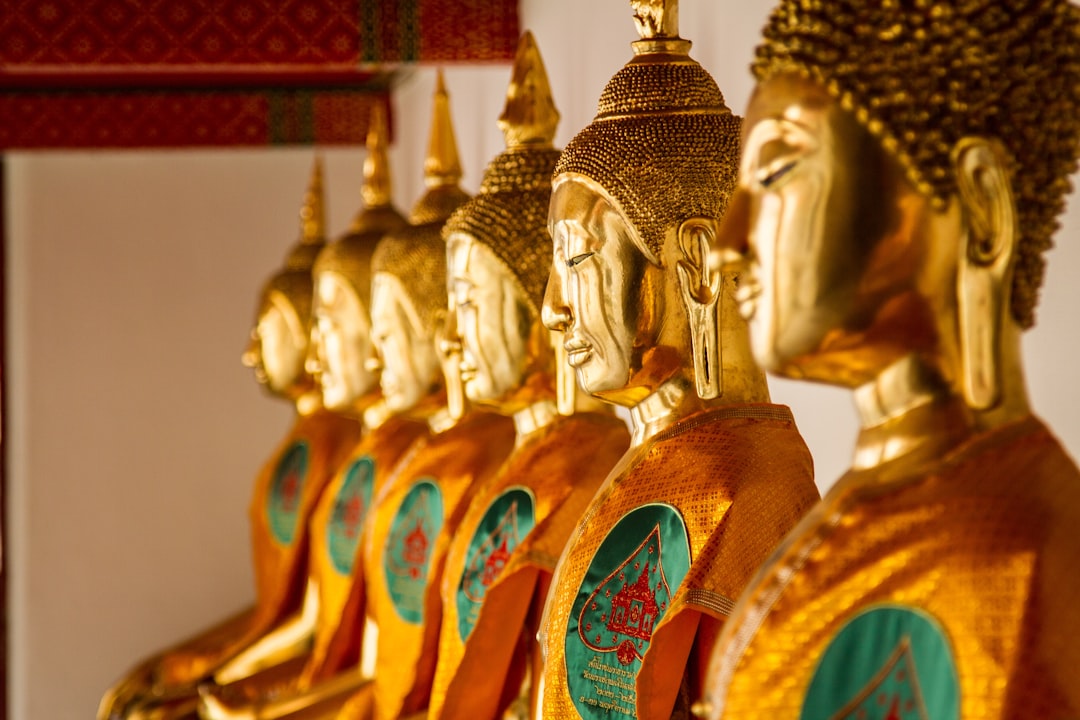 Photo from Unsplash
Photo from Unsplash
Originally Posted On: https://heartsfuneralsg.com/the-role-of-chanting-in-buddhist-funeral-ceremonies/
Losing a loved one is never easy, and the grief that follows can be overwhelming. In times of sadness and loss, many Singaporeans turn to their cultural and religious traditions for solace and guidance. For Buddhists, funeral ceremonies hold a special place in providing comfort and a sense of closure.
Chanting plays a central role in Buddhist funeral ceremonies, offering a unique way to pay respects to the departed and find inner peace during a difficult time. In this article, we’ll explore the world of Buddhist funeral chanting in a simple and informative manner, shedding light on this important aspect of the grieving process.
Understand how chanting can help you cope with loss and honor the memory of your loved ones. Along the way, we’ll learn about the different types of chants, the process involved, and how it can provide a source of strength and comfort during challenging times.
Understanding Buddhist Funeral Ceremonies
Buddhist funeral ceremonies hold deep significance in Singaporean culture, offering a way to bid farewell to the departed with dignity and respect. They are a blend of spiritual and cultural traditions that vary among different Buddhist communities, such as Theravada, Mahayana, and Vajrayana.
These ceremonies serve several important purposes. Firstly, they provide a structured way for family and friends to mourn the loss of a loved one together, offering emotional support during a difficult period. Secondly, they offer prayers and blessings for the deceased, wishing them a smooth journey to the next life. Lastly, they help guide the grieving process, encouraging acceptance and healing.
While there are variations based on regional customs and individual preferences, some common elements are found in most Buddhist funeral ceremonies. These typically include setting up an altar, offering incense and flowers, and the central role of chanting.
Chanting, in particular, stands out as a powerful practice that not only honors the deceased but also offers a means of finding peace within oneself. It creates a sacred atmosphere that brings a sense of connection to something larger than ourselves.
The Importance of Chanting
Chanting is a cornerstone of Buddhist funeral ceremonies, serving as a bridge between the physical and spiritual realms. It’s a practice deeply rooted in Buddhist traditions, dating back to the time of the Buddha himself. The soothing rhythm and melodious intonations of chants create an atmosphere of reverence and mindfulness.
At its core, chanting is a form of prayer. It involves reciting sacred verses, known as mantras, sutras, or gathas, often in the ancient languages of Pali or Sanskrit. These verses hold profound spiritual meanings, and their repetition during a funeral ceremony serves multiple purposes.
One of the key purposes of chanting is to invoke blessings and positive energies for the deceased. Buddhists believe that the sound of these sacred verses has the power to guide the departed soul towards a peaceful afterlife. Chanting is also a way to express gratitude and love for the departed, offering them the best possible journey to their next existence.
Moreover, chanting has a profound impact on the living as well. The soothing and repetitive nature of the chants can help ease the minds and hearts of mourners. In the midst of grief and sorrow, the act of chanting can be a source of comfort and solace, providing a much-needed moment of respite from the pain of loss.
In essence, chanting in Buddhist funeral ceremonies plays a crucial role in bringing spiritual depth and emotional support to those who have lost someone dear. It reminds us of the impermanence of life and the importance of cherishing the time we have with our loved ones.
Types of Chants Used
In Buddhist funeral ceremonies, several types of chants are employed, each with its own significance and purpose. These chants are recited by monks, nuns, or family members, and they vary depending on the specific tradition and customs followed. Here are the main types of chants you may encounter:
- Mantras: Mantras are short, repetitive phrases or syllables with deep spiritual meanings. They are often considered to have protective and purifying qualities. In funeral ceremonies, mantras are chanted to invoke blessings for the deceased and to create a positive energy field that guides the departed soul.
- Sutras: Sutras are sacred texts or scriptures in Buddhism that contain the teachings of the Buddha. Chanting sutras during a funeral ceremony not only honors the Buddha’s wisdom but also offers solace and blessings to the departed. The Heart Sutra and the Amitabha Sutra are commonly recited sutras during these ceremonies.
- Gathas: Gathas are verses or hymns composed for specific occasions, including funerals. They often express gratitude, remembrance, and good wishes for the deceased. Gathas may be more accessible to those who are not familiar with the intricacies of Buddhist scripture, making them relatable to a wider audience.
Each type of chant carries a unique spiritual resonance and can evoke different emotions among mourners. The selection of chants is often influenced by the wishes of the deceased or their family and the specific Buddhist tradition being followed.
The Chanting Process
Chanting during a Buddhist funeral ceremony follows a structured sequence of events, creating a harmonious and meaningful experience for both the deceased and the living. This process plays a pivotal role in guiding the departed soul and providing comfort to the grieving family. Here’s an overview of the typical chanting process:
- Preparation and Setting the Altar: Before the actual chanting begins, there is a period of preparation. An altar is set up, adorned with offerings such as incense, candles, flowers, and a portrait of the deceased. This altar serves as the focal point for the ceremony and is a symbol of reverence.
- Invocations and Prayers: The ceremony commences with invocations and prayers led by Buddhist monks or nuns. These invocations seek blessings for the deceased and set a sacred atmosphere for the chanting to follow. Mourners often join in these initial prayers, expressing their respect and love for the departed.
- Chanting During the Ceremony: The heart of the ceremony involves the chanting of mantras, sutras, or gathas. This chanting is typically led by the monastic clergy, and mourners are encouraged to participate by following along with the verses. The rhythm and cadence of the chants create a serene ambiance, allowing everyone present to connect with the spiritual aspect of the event.
- Concluding Chants and Dedications: Towards the end of the ceremony, there are concluding chants and dedications. These may involve expressing gratitude to the monastic community, dedicating merits to the deceased, and extending blessings to all sentient beings. It is a way of reinforcing the interconnectedness of all living beings.
The chanting process is not just a passive ritual; it is an active and participatory experience. By engaging in the chanting, mourners can find solace, focus their minds, and gain a sense of spiritual connection with the departed and the larger Buddhist community.
During this challenging time, the presence of Buddhist monks or nuns is invaluable. They guide the ceremony, provide spiritual support, and ensure that the chanting process flows smoothly. Their presence serves as a source of comfort and guidance for the grieving family and friends.
The Impact of Chanting
Chanting in Buddhist funeral ceremonies goes beyond the mere recitation of words; it has a profound impact on both the mourners and the departed. Understanding this impact is crucial to appreciating the significance of this practice in the grieving process.
- Providing Comfort to the Grieving: Chanting offers a form of solace to those who are mourning the loss of a loved one. The rhythmic and melodic nature of the chants can have a calming effect, helping to ease the emotional turmoil that often accompanies grief. It provides a brief respite from the overwhelming sorrow, allowing mourners to find moments of inner peace.
- Guiding the Departed Soul: Buddhists believe that chanting helps guide the departed soul on its journey to the next life. The positive energy generated through chanting and the merits accumulated during the ceremony are thought to assist the deceased in transitioning to a favorable rebirth. This belief brings a sense of purpose to the chanting, as it is seen as a loving and supportive gesture towards the departed.
- Fostering Mindfulness and Acceptance: Chanting encourages mindfulness, focusing the mind on the present moment. This can be especially helpful during a time when grief can lead to overwhelming thoughts and emotions. By engaging in the chanting, mourners are reminded of the impermanence of life and the importance of acceptance in the face of loss.
- Strengthening Community Bonds: Chanting during a Buddhist funeral ceremony is a communal activity. It brings together family, friends, and the monastic community in a shared spiritual endeavor. This sense of togetherness can be comforting, reminding mourners that they are not alone in their grief and that there is a wider network of support.
- Expressing Love and Respect: Chanting is a tangible way to express love and respect for the deceased. Through the act of reciting sacred verses and dedicating merits, mourners honor the memory of their loved one. It is a heartfelt gesture that allows them to feel connected to the departed in a meaningful way.
Overall, the impact of chanting in Buddhist funeral ceremonies is multi-faceted, addressing the spiritual, emotional, and communal needs of those involved. It serves as a source of strength and guidance during a challenging period, reminding us of the enduring bond we share with our loved ones even after they have passed on.
Cultural Variations in Chanting
Buddhism is a diverse and global faith, with a wide range of traditions and practices. As a result, the chanting styles and rituals used in Buddhist funeral ceremonies can vary significantly among different cultural and regional communities. Here are some examples of cultural variations in Buddhist funeral chanting:
- Theravada Buddhism: In Theravada traditions, which are prevalent in countries like Sri Lanka, Thailand, and Myanmar, funeral chanting often involves recitations of Pali scriptures. The recitation of the Paritta Suttas (Protective Discourses) is common, as they are believed to offer protection and blessings to the deceased. These chants are typically led by monks in Theravada ceremonies.
- Mahayana Buddhism: In Mahayana traditions, found in countries like China, Japan, and Korea, chanting is an integral part of funeral ceremonies. The Heart Sutra (Prajñāpāramitā Hṛdaya Sūtra) and the Amitabha Sutra are frequently recited. Family members may also participate in chanting alongside the monastic clergy.
- Tibetan Buddhism: Tibetan Buddhist funeral ceremonies are distinct in their use of unique chants and rituals. The Tibetan Book of the Dead (Bardo Thodol) is often recited to guide the deceased through the intermediate state between death and rebirth. Tibetan Buddhists also incorporate chanting of mantras, such as the Om Mani Padme Hum mantra.
- Zen Buddhism: Zen Buddhism, known for its simplicity and focus on meditation, may have less elaborate chanting during funeral ceremonies. The emphasis is often on silent meditation and contemplation, although some Zen communities may still incorporate sutra recitations.
- Singaporean Buddhism: In Singapore, which has a multicultural Buddhist community, funeral chanting can vary based on individual preferences and the specific Buddhist tradition followed by the family. It’s not uncommon to find a blend of Theravada, Mahayana, and other Buddhist elements in funeral ceremonies, reflecting the diverse makeup of the community.
These cultural variations highlight the rich tapestry of Buddhist funeral traditions and the flexibility within the faith to adapt to different cultural contexts. Regardless of the specific tradition, the underlying intention of offering blessings to the deceased and providing support to the grieving remains consistent.
Modern Adaptations and Challenges
As Singapore continues to evolve and modernize, so too have Buddhist funeral ceremonies and chanting practices adapted to meet the changing needs and preferences of the population. While preserving traditional customs is important, modern adaptations have become necessary to accommodate the fast-paced lifestyles and diverse cultural backgrounds of Singaporeans.
1. Technology and Live Streaming: In the age of technology, funeral services and chanting can now be live-streamed to include family and friends who may be unable to attend in person. This adaptation has allowed for broader participation and support during the grieving process.
2. Multilingual Chanting: Singapore’s multicultural society has led to a demand for multilingual chanting, ensuring that all family members and attendees can understand and participate in the ceremony. Chants may be recited in multiple languages, including English, Mandarin, Tamil, and Malay, depending on the cultural background of the deceased and their family.
3. Inclusivity and Gender Roles: Modern Buddhist funeral ceremonies are becoming more inclusive. While traditionally led by monks or nuns, there is a growing acceptance of lay Buddhists, both male and female, playing active roles in leading chants and conducting ceremonies. This change reflects a more gender-inclusive approach to religious practices.
4. Eco-Friendly Practices: Environmental consciousness has prompted the adoption of eco-friendly funeral practices. This includes practices like green burials or cremations that have a lower impact on the environment. Chanting often accompanies these eco-friendly practices, emphasizing the impermanence of life and the interconnectedness of all living beings.
5. Addressing Controversies: Modern adaptations also require addressing controversies within the Buddhist community, such as disputes over funeral rites, the commercialization of funeral services, and ethical concerns related to the treatment of the deceased. These issues are being discussed openly within the community as Singaporeans seek to maintain the integrity of their traditions while ensuring ethical practices.
In conclusion, Buddhist funeral chanting in Singapore has not remained stagnant but has evolved to meet the changing needs and expectations of the modern world. While these adaptations aim to make the ceremonies more accessible and relevant, they still carry the essence of honoring the departed and providing comfort to those who mourn.
It is essential to strike a balance between preserving cherished traditions and embracing modernity, allowing Buddhist funeral ceremonies to continue serving as a source of solace and spiritual guidance for generations to come. In times of loss, these ceremonies and the practice of chanting play a vital role in bringing solace and understanding to the grieving heart.





